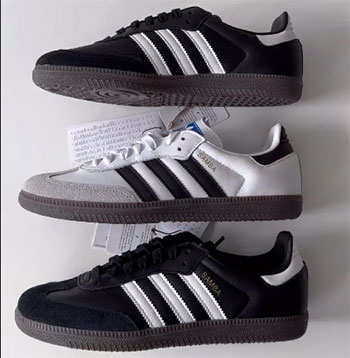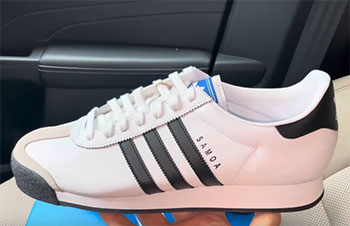The adidas Samba and Samoa are two of the brand’s most iconic shoe styles. Both have a rich history and heritage on the pitch and streets, but they also have some key differences.
In this comprehensive guide, we’ll compare the Samba and Samoa, looking at the history, design, fit, and key features of each model. We’ll break down the pros and cons so you can decide which adidas classic is best for you.
A Brief Comparison Table
| Feature | Samba | Samoa |
| Silhouette | Wider, rounded | Narrower, curved |
| Toe Box | Wider, rounder | Narrower, lower profile |
| Outsole | Gum rubber | Flat rubber |
| Weight | Slightly heavier | More lightweight |
| Fit | True to size, wide | Runs narrow, size up 0.5 |
| Ankle Collar | Padded | Low cut, slim |
| Soccer Performance | Excellent traction, lateral support | Better for running/training |
| Style Versatility | Iconic, timeless | Athletic look, still stylish |
| Comfort | Roomy toe box, well-cushioned | Break-in period, snug toe |
| Overall | Premium materials, iconic heritage | Great value, excellent quality |
A Brief History Of The Samba And Samoa
First, let’s take a quick look at the origins and background of each shoe.
The Adidas Samba

The Samba first hit the shelves in 1950 as adidas’ first ever purpose-built indoor soccer shoe.
Its non-marking gum rubber outsole was ideal for grip and control on indoor hardwood and concrete.
The distinct three stripes, suede upper, and gum rubber outsole made the Samba instantly recognizable.
It quickly became popular both on and off the pitch, becoming a streetwear staple.
Several iterations have released over the years featuring different materials and colorways.
But the classic Samba design has remained largely unchanged.
The Adidas Samoa
The Samoa has its roots in adidas’ marathon running shoes of the 1980s. It was designed as a lightweight training shoe for sprinters and middle distance runners.
It was originally named the adidas Samba Millennium before being renamed to the Samoa in the late 1990s. The Samoa featured a slimmed down last and a grippy flat rubber outsole.
Like the Samba, the Samoa also became popular as a lifestyle shoe. Its simple and clean design worked well on the streets. The Samoa has released in many colorways but always sticks to its running shoe roots.
Samba Vs. Samoa: Key Differences
Now that we’ve looked at the origins of each shoe, let’s compare the key differences between the Samba and Samoa:
- Silhouette – The Samba has a wider, more rounded silhouette optimized for lateral movements. The Samoa has a narrower, more curved heel-to-toe silhouette ideal for running and training.
- Toe box – The Samba has a wider, rounder toe box for controlling the ball with your feet. The Samoa has a narrower, lower-profile toe box streamlined for running.
- Outsole – The Samba has the brand’s classic gum rubber outsole ideal for indoor surfaces. The Samoa has a flat rubber outsole designed for training on track and field.
- Weight – The Samba is slightly bulkier and heavier, while the Samoa is more lightweight and minimalist.
- Fit – The Samba fits true to size but slightly wider. The Samoa runs narrower through the toe box so sizing up half a size is recommended.
- Ankle collar – The Samba has soft, padded ankle collars for comfort. The Samoa has a low cut slimmer collar.
Samba Vs. Samoa: Upper & Construction
Now let’s compare the materials and construction quality of each shoe:

- Samba – Features premium suede uppers for a soft touch and durability. Padded tongue and collar enhance comfort. Seamless toe cap and T-toe construction increase ball contact and control.
- Samoa – Durable nubuck leather uppers deliver a premium look and feel. Contains synthetic suede overlays for added structure and support. Lower cut provides ankle mobility.
- Overall – The Samba uses higher quality and more premium materials. But the Samoa still delivers good durability, comfort, and value given its lower price point.
Samba Vs. Samoa For Soccer & Training
When it comes to performance, here’s how the shoes compare:
- Samba – Excellent traction and feel on indoor surfaces like hardwood, concrete, and turf. Provides lateral support for quick changes of direction. Cushioned for comfort during games and practice.
- Samoa – Lightweight and responsive. Low-profile gives excellent ground contact for sprints and training. Better suited for track workouts than games.
- Soccer – The Samba is the clear winner for indoor soccer with its wider fit, cushioning, and grippy gum rubber outsole.
- Training – For sprint training and track workouts, the Samoa is ideal. But the Samba can also work for general training.
Also Read: Choose Between Nortiv 8 And Merrell.
Style & Everyday Wear
As for style and streetwear appeal, both shoes have their merits:
- Samba – The classic slim profile and gum sole make the Samba extremely versatile for casual wear. Works well with jeans, joggers, and shorts.
- Samoa – The Samoa has a slimmer silhouette that’s stylish but more athletic looking. Great paired with track pants, shorts, and casual outfits.
- Style – It’s largely personal preference. But the Samba has a slight edge as one of adidas’ most iconic and timeless styles.
Sizing & Comfort
When it comes to sizing and comfort, keep these tips in mind:
- Samba – Order true to size. Wider than the Samoa with a comfortable, spacious toe box. Padded collar enhances comfort. Break-in time is minimal.
- Samoa – Size up half a size for the best fit. The toe box runs narrower but expands after break-in. Collar is relatively stiff at first wear.
- Sizing – The Samba offers a truer, wider fit. But the Samoa will contour after break-in if sized up half a size.
- Comfort – The Samba is more comfortable out of the box but the Samoa rivals it after break-in. Both offer good arch support and impact cushioning.
Price & Value
Lastly, pricing and overall value:
- Samba – Retails for $100 which is very fair for the premium materials and quality. Holds its value very well over time.
- Samoa – Usually around $65-75 making it an excellent value. Durability is still good given the lower price point.
- Price – The Samba costs $25-35 more but offers premium suede, quality construction, and iconic status.
- Value – The Samoa punches above its weight class given the sub $100 price. But the Samba is still worth the extra investment long term.
Also watch this video!
Frequently Asked Questions (FAQ)
The Samba is having a major renaissance lately thanks to its iconic retro design and versatility as a lifestyle shoe. It looks great with all sorts of casual outfits from streetwear to preppy. Plus it offers comfortable cushioning you can wear all day long.
The Samba often sells out quickly since it’s so popular right now. adidas makes consistent re-stocks but limited quantities mean the Samba is hard to find at times, driving up resale prices. Check adidas.com regularly for restocks to get them at retail price.
The Samba and Gazelle have similar retro adidas styling but some key differences. The Samba has an indoor soccer shoe design with a wider silhouette and gum rubber outsole. The Gazelle has a narrower shape optimized for running and training with a track-style outsole.
It’s hard to go wrong with either the classic black or white Samba colorways. Black is more versatile and pairs with anything. White has that crisp, iconic Samba look. So choose based on your wardrobe, keeping the white Sambas looking clean takes more care.
Also Read: Comparison Between Ariat Hilo And Hey Dude.
The Verdict
In summary, here are the key takeaways when comparing the Samba and Samoa:
- Soccer & Training – Samba is better for indoor soccer. Samoa is ideal for running and track workouts.
- Style – Samba is more iconic and versatile. But Samoa still looks great with casual wear.
- Sizing & Comfort – Samba fits true to size with superior comfort. Samoa runs narrow but will break-in.
- Value – Samba justifies its higher price with premium details. But Samoa offers great value at a budget-friendly price point.
For soccer players and sneakerheads, it’s hard to go wrong with either of these adidas classics. Both offer great style, performance, and long lasting enjoyment.
Choose the Samba if you prioritize iconic streetwear looks, wider fit, and cushioning for indoor surfaces. Go with the Samoa if you want a sharp, lightweight trainer for running that can still look stylish off the track.
